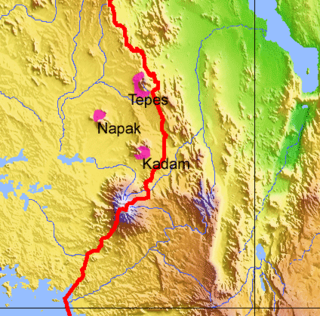Soo language
| Soo | |
|---|---|
| Tepes | |
| Region | Uganda |
| Ethnicity | 5,000 (2007)[1] |
Native speakers | 50 (2012)[1] |
| Dialects |
|
| Language codes | |
| ISO 639-3 | teu |
| Glottolog | sooo1256 |
| ELP | Soo |
 | |
Soo or So is the
There are between 3,000 and 10,000 ethnic Soo people (Carlin 1993). They were historically hunter-gatherers, but have recently shifted to pastoralism and subsistence farming like their Nilotic and Bantu neighbors.[2] Beer (2009: 2) found that most Soo villages have only one speaker remaining. Thus, the speakers rarely have a chance to actively use the Soo language.
Dialects
Soo dialects are spoken on the slopes of the following three mountains in east-central Uganda just to the north of Mount Elgon.[3]
- Tepes dialect (also called Tepeth), on the slopes of
- Kadam dialect, on the slopes of Pokot.[5]According to Carlin (1993), Mount Kadam has the highest concentration of ethnic So people.
- Napak dialect, on the slopes of Mount Napak in Napak District, Uganda (no speakers found as of 1993).
There are fewer than 60 elderly speakers of all three dialects combined.[2]
Carlin (1993: 2-3) notes that there are only minor differences between the Tepes and Kadam dialects, which are mutually intelligible.
Grammar
So grammar has been described by Beer, et al. (2009).[9]
Word order is VSO (
Pronouns
So nominative and accusative pronouns are:[9]
| Singular | Plural | |
|---|---|---|
| 1st | aja | inja/izja |
| 2nd | bija | bitja |
| 3rd | ica | iɟa |
Interrogatives
So interrogatives are:[9]
- Who/What: /ic/
- When: /ita/
- Where: /eoko/
- Why: /ikun/
- How: /gwate/
- How Many/How Much: /intanac/
Tenses
There are four verb tenses:[9]
- past tense
- present tense
- future tense (general)
- future tense (specific)
Affixes
Some So affixes are:[9]
- /kɔ-/: immediate future
- /-ak/: passivity
- /no-/: relative clause coordinator
- /ɪn-/: general negation
- /lan/: past negation
- /ipa/: imperative negation
- /-tɛz/: inchoative marker
- /-uk/: locative marker
- /-ok/: instrumental marker
- /-a/: goal marker
- /kun-/: dative pronouns
- /-ak/: dative pronouns
Singular suffixes are /-at/, /an/, /-ɛn/, and /-it/.
Plural suffixes are /-in/, /-ɛk/, /-ɛz/, /-an/, /-ɛl/, /-ra/, /-ce/, /-ɔt/, and /-e/.
References
- ^ a b Soo at Ethnologue (18th ed., 2015) (subscription required)
- ^ a b Beer (2009: 1)
- ^ Carlin, Eithne. 1993. The So Language. (Afrikanistische Monografien (AMO), 2.) Institut für Afrikanistik, Universität zu Köln.
- ^ a b Beer (2009: 2)
- ^ a b Carlin (1993: 6)
- ^ Carlin (1993: 7-8)
- ^ Carlin (1993: 8)
- ^ Heine, Bernd. m.s. The So Language of Eastern Uganda.
- ^ a b c d e f Beer, Sam, Amber McKinney, Lokiru Kosma 2009. The So Language: A Grammar Sketch. m.s.
